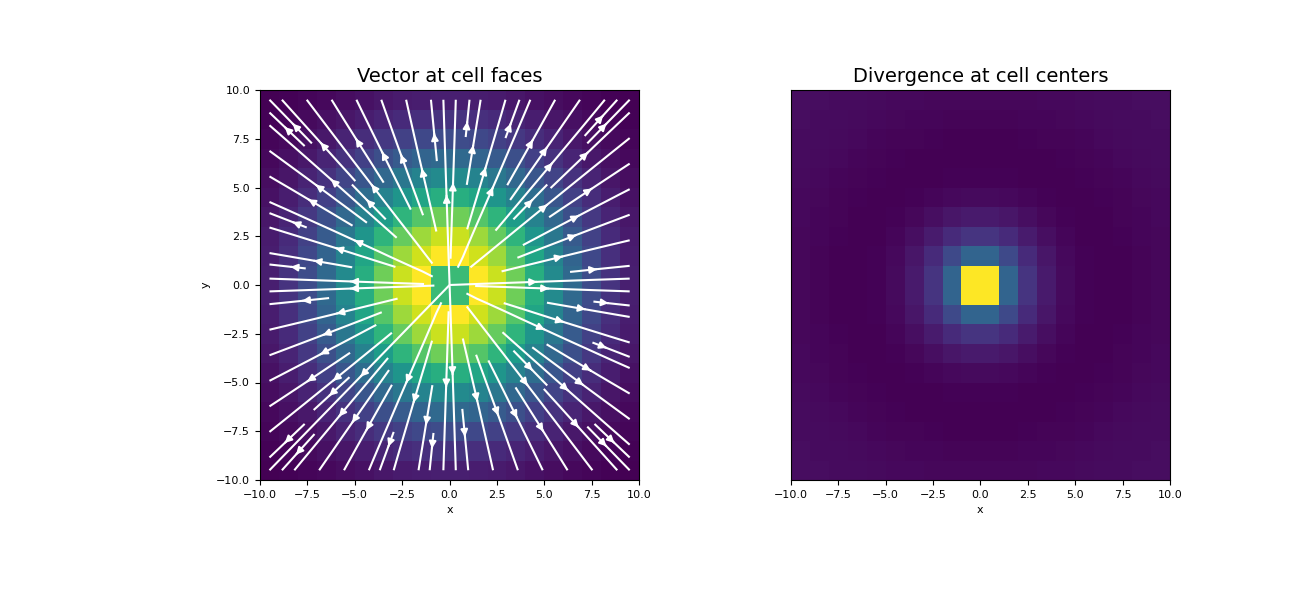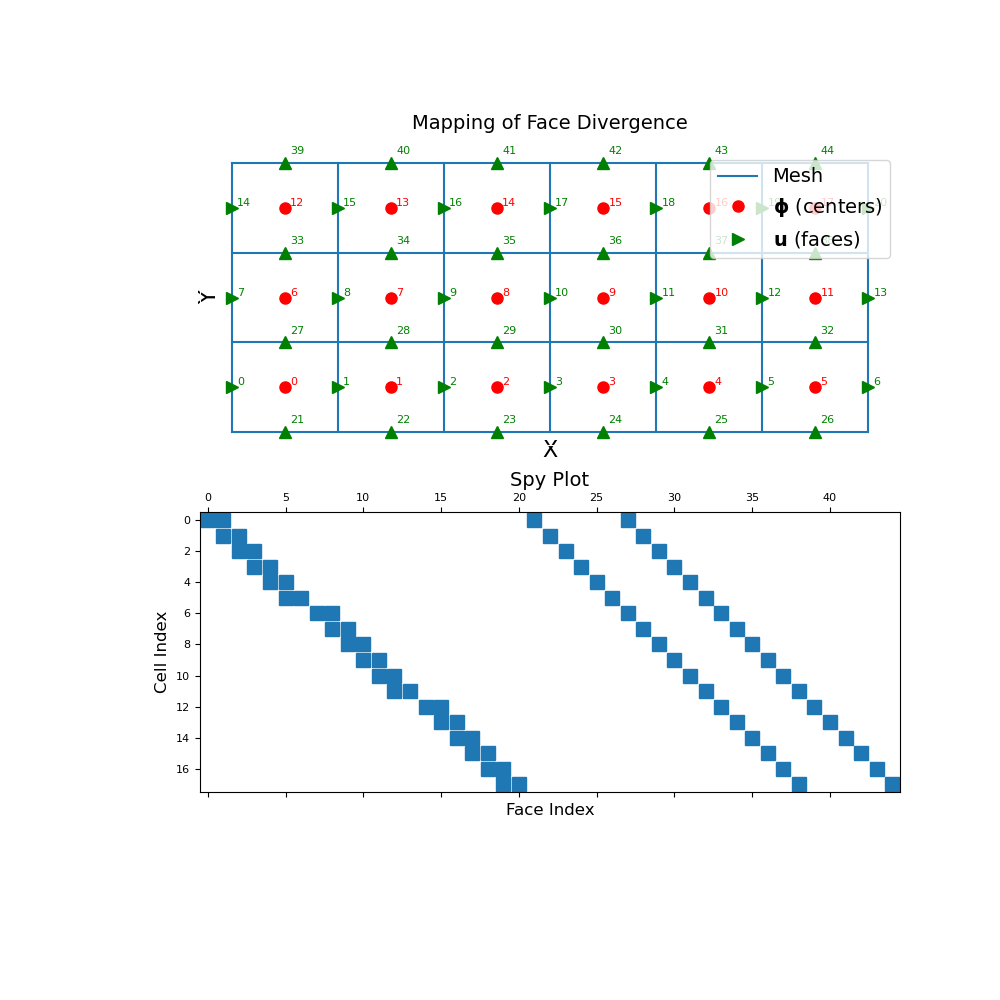discretize.base.BaseRegularMesh.face_divergence#
- property BaseRegularMesh.face_divergence#
Face divergence operator (faces to cell-centres).
This property constructs the 2nd order numerical divergence operator that maps from faces to cell centers. The operator is a sparse matrix \(\mathbf{D_f}\) that can be applied as a matrix-vector product to a discrete vector \(\mathbf{u}\) that lives on mesh faces; i.e.:
div_u = Df @ u
Once constructed, the operator is stored permanently as a property of the mesh. See notes for additional details.
- Returns:
- (
n_cells,n_faces)scipy.sparse.csr_matrix The numerical divergence operator from faces to cell centers
- (
Notes
In continuous space, the divergence operator is defined as:
\[\phi = \nabla \cdot \vec{u} = \frac{\partial u_x}{\partial x} + \frac{\partial u_y}{\partial y} + \frac{\partial u_z}{\partial z}\]Where \(\mathbf{u}\) is the discrete representation of the continuous variable \(\vec{u}\) on cell faces and \(\boldsymbol{\phi}\) is the discrete representation of \(\phi\) at cell centers, face_divergence constructs a discrete linear operator \(\mathbf{D_f}\) such that:
\[\boldsymbol{\phi} = \mathbf{D_f \, u}\]For each cell, the computation of the face divergence can be expressed according to the integral form below. For cell \(i\) whose corresponding faces are indexed as a subset \(K\) from the set of all mesh faces:
\[\phi_i = \frac{1}{V_i} \sum_{k \in K} A_k \, \vec{u}_k \cdot \hat{n}_k\]where \(V_i\) is the volume of cell \(i\), \(A_k\) is the surface area of face k, \(\vec{u}_k\) is the value of \(\vec{u}\) on face k, and \(\hat{n}_k\) represents the outward normal vector of face k for cell i.
Examples
Below, we demonstrate 1) how to apply the face divergence operator to a discrete vector and 2) the mapping of the face divergence operator and its sparsity. Our example is carried out on a 2D mesh but it can be done equivalently for a 3D mesh.
We start by importing the necessary packages and modules.
>>> from discretize import TensorMesh >>> import numpy as np >>> import matplotlib.pyplot as plt >>> import matplotlib as mpl
Define a 2D mesh
>>> h = np.ones(20) >>> mesh = TensorMesh([h, h], "CC")
Create a discrete vector on mesh faces
>>> faces_x = mesh.faces_x >>> faces_y = mesh.faces_y >>> ux = (faces_x[:, 0] / np.sqrt(np.sum(faces_x ** 2, axis=1))) * np.exp( ... -(faces_x[:, 0] ** 2 + faces_x[:, 1] ** 2) / 6 ** 2 ... ) >>> uy = (faces_y[:, 1] / np.sqrt(np.sum(faces_y ** 2, axis=1))) * np.exp( ... -(faces_y[:, 0] ** 2 + faces_y[:, 1] ** 2) / 6 ** 2 ... ) >>> u = np.r_[ux, uy]
Construct the divergence operator and apply to face-vector
>>> Df = mesh.face_divergence >>> div_u = Df @ u
Plot the original face-vector and its divergence
>>> fig = plt.figure(figsize=(13, 6)) >>> ax1 = fig.add_subplot(121) >>> mesh.plot_image( ... u, ax=ax1, v_type="F", view="vec", stream_opts={"color": "w", "density": 1.0} ... ) >>> ax1.set_title("Vector at cell faces", fontsize=14) >>> ax2 = fig.add_subplot(122) >>> mesh.plot_image(div_u, ax=ax2) >>> ax2.set_yticks([]) >>> ax2.set_ylabel("") >>> ax2.set_title("Divergence at cell centers", fontsize=14) >>> plt.show()
(
Source code,png,pdf)
The discrete divergence operator is a sparse matrix that maps from faces to cell centers. To demonstrate this, we construct a small 2D mesh. We then show the ordering of the elements in the original discrete quantity \(\mathbf{u}\) and its discrete divergence \(\boldsymbol{\phi}\) as well as a spy plot.
>>> mesh = TensorMesh([[(1, 6)], [(1, 3)]]) >>> fig = plt.figure(figsize=(10, 10)) >>> ax1 = fig.add_subplot(211) >>> mesh.plot_grid(ax=ax1) >>> ax1.plot( ... mesh.cell_centers[:, 0], mesh.cell_centers[:, 1], "ro", markersize=8 ... ) >>> for ii, loc in zip(range(mesh.nC), mesh.cell_centers): ... ax1.text(loc[0]+0.05, loc[1]+0.02, "{0:d}".format(ii), color="r") >>> ax1.plot( ... mesh.faces_x[:, 0], mesh.faces_x[:, 1], "g>", markersize=8 ... ) >>> for ii, loc in zip(range(mesh.nFx), mesh.faces_x): ... ax1.text(loc[0]+0.05, loc[1]+0.02, "{0:d}".format(ii), color="g") >>> ax1.plot( ... mesh.faces_y[:, 0], mesh.faces_y[:, 1], "g^", markersize=8 ... ) >>> for ii, loc in zip(range(mesh.nFy), mesh.faces_y): ... ax1.text(loc[0] + 0.05, loc[1] + 0.1, "{0:d}".format((ii + mesh.nFx)), color="g")
>>> ax1.set_xticks([]) >>> ax1.set_yticks([]) >>> ax1.spines['bottom'].set_color('white') >>> ax1.spines['top'].set_color('white') >>> ax1.spines['left'].set_color('white') >>> ax1.spines['right'].set_color('white') >>> ax1.set_xlabel('X', fontsize=16, labelpad=-5) >>> ax1.set_ylabel('Y', fontsize=16, labelpad=-15) >>> ax1.set_title("Mapping of Face Divergence", fontsize=14, pad=15) >>> ax1.legend( ... ['Mesh', r'$\mathbf{\phi}$ (centers)', r'$\mathbf{u}$ (faces)'], ... loc='upper right', fontsize=14 ... ) >>> ax2 = fig.add_subplot(212) >>> ax2.spy(mesh.face_divergence) >>> ax2.set_title("Spy Plot", fontsize=14, pad=5) >>> ax2.set_ylabel("Cell Index", fontsize=12) >>> ax2.set_xlabel("Face Index", fontsize=12) >>> plt.show()

